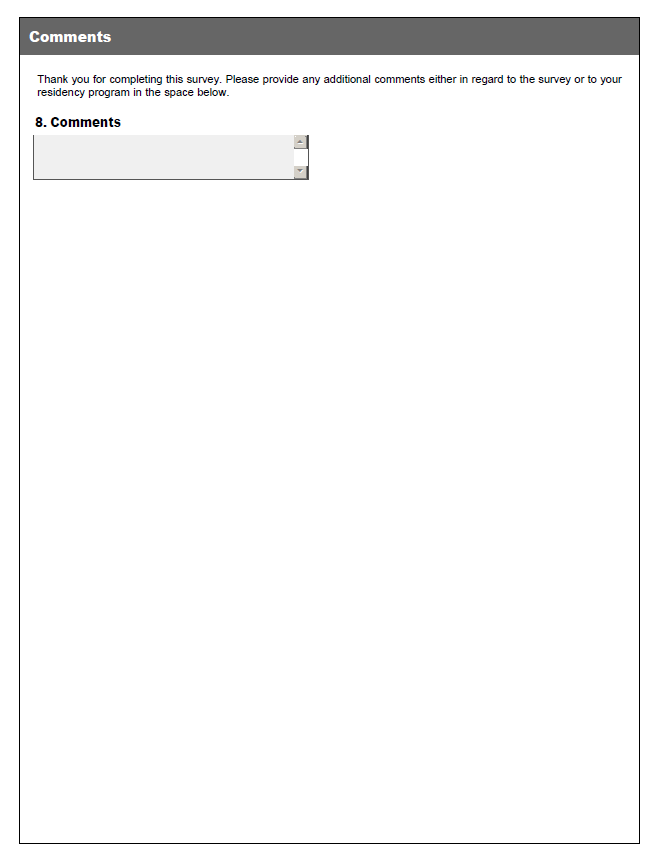Supporting Statement A THC Eval 25 Feb 2014
Supporting Statement A THC Eval 25 Feb 2014.docx
Evaluation and Initial Assessment of HRSA Teaching Health Centers
OMB: 0915-0376
Supporting Statement A
Title of the Data Collection
OMB Control No. 0915-XXXX
Terms of Clearance: For revisions, extensions, or reinstatements list terms of clearance here. Explain how the terms of clearance are addressed in the submission. If there were no terms of clearance, please indicate “None”.
A. Justification
Circumstances Making the Collection of Information Necessary
Section 5508 of the Affordable Care Act of 2010 (ACA) established the Teaching Health Center Graduate Medical Education (THCGME) program under Title III of the Public Health Service Act to support the expansion of new and existing primary care residency training programs in community-based settings. The primary goals of this program are to increase the production of primary care doctors who are well prepared to practice in community settings, particularly with underserved populations, and to improve the overall number and geographic distribution of primary care providers.
The legislation specifically requires that THC programs report annually on the types of primary care residents trained, the number trained, the number who complete residency, the number who care for vulnerable populations, and any other information as deemed appropriate by the Secretary. The law states:
(1) ANNUAL REPORT. The report required under this paragraph for a qualified teaching health center for a fiscal year is a report that includes (in a form and manner specified by the Secretary) the following information for the residency academic year completed immediately prior to such fiscal year:
A) The types of primary care resident approved training programs that the qualified teaching health center provided for residents.
(B) The number of approved training positions for residents described in paragraph (4).
(C) The number of residents described in paragraph (4) who completed their residency training at the end of such residency academic year and care for vulnerable populations living in underserved areas.
(D) Other information as deemed appropriate by the Secretary.”
This program aims to increase the number of new primary care physicians and dentists trained in community-based settings who go on to practice in primary care and in rural and underserved settings. The THCGME program differs from traditional funding of GME programs, largely through Medicare, by requiring that the funding go directly to a community-based ambulatory patient care site. This program is significantly different than traditional Medicare GME which is paid largely to inpatient hospitals, and therefore the THCGME program is expected to incentivize a different model of training with the aim of producing primary care providers who are better trained to provide primary care and practice in community-based, often underserved, settings.
The George Washington University (GW), through a competitive process, was awarded the Evaluation and Initial Assessment of HRSA Teaching Health Centers contract. The purpose of this contract is to conduct an assessment over a five year period to better understand this model of community-based residency training and examine the outcomes of the THC programs, in terms of production of primary care providers and providers who practice in underserved settings.
GW plans to collect information from THC programs regarding the types of primary care residency programs and numbers trained, as well as information on curricular components that demonstrate community and primary care orientation. GW also plans to directly gather information from THC residents and alumni using a multi-staged survey format to establish a baseline census of the individuals who choose THC programs and determine the career outcomes of THC graduates. Research has shown that certain factors are associated with primary care and underserved career choices. At the individual level these factors include gender, age, rural background, student debt levels, and intent to practice in certain specialties or settings. Medical school level factors have also been shown to correlate with career outcomes, including primary care and rural experiences. Collecting this information is important both to assess whether THC programs are attracting those residents who are most likely to choose primary care and underserved careers, as well as to assess the relationship of these factors with future outcomes for THC programs.
Purpose and Use of Information Collection
In order to ensure the goals and reporting requirements of the THCGME program are met, GW, under contract with BHPr, has developed four instruments to collect data from each of the programs and their residents: 1) Program Data Collection Tool, 2) THC Matriculant Survey, 3) THC Graduation Survey and 4) THC Graduate Survey. Data Collection Instruments:
Data Collection Instrument |
Subject (Recipient) |
Timeline |
|
Program manager |
Annual – August/Sept |
|
Matriculating resident |
Annual – July* |
|
Graduating resident |
Annual – June* |
|
Graduate physician (one year post graduation) |
Annual – June* |
* Surveys will be implemented annually with different cohorts of matriculating, graduating and alumni residents (academic years for residency programs run from July to June); surveys will be implemented by GW, under contract with HRSA, through the end of the 5 year evaluation contract and then provided as a resource for THC programs to continue collecting information on their residents and graduates.
The Program Data Collection Tool provides information on residency programs that receive funding for THC residents. The Program Data Collection Tool will be administered on an annual basis to THC Program Directors. It will collect basic organizational and training characteristics of the programs (including program specialty, numbers trained, training sites, educational partners, and residency program financing), educational initiatives (particularly around training for changing health care delivery systems and community experiences), and health center characteristics (including current workforce and vacancies, clinical service provided by residents, and participation in workforce programs such as National Health Service Corps).
The tool addresses the following evaluation research questions:
What are the types of primary care resident approved training programs provided by the THC programs?
What number of approved training positions is being provided by the THC programs?
What advanced primary care delivery models (i.e. patient centered medical homes, inter-professional team-based care, quality improvement) are THC residents training in?
What community-based experiences are THC residents receiving?
What is the amount of training THC residents receive in the primary care setting?
See Appendix A for the Program Data Collection Tool. This information will be used to monitor program activities and inform program management within BHPr. In addition, this information is critical to understand the characteristics of a new program and follow its progress over time.
Furthermore, three questionnaires have been developed for implementation with all THC residents at matriculation, graduation and one year post-graduation: THC Matriculant Survey, THC Graduation Survey, and THC Graduate Survey. These three surveys will be administered to gather information on THC residents at different stages of their training and early clinical practice. The surveys are intended to identify the absolute number of primary care providers and providers that practice in underserved areas. This is a critical outcome measure for the THCGME program as THCs must be new or expanding residency programs. Therefore, THC graduates are new primary care providers above the number that would have been produced in the GME system prior to the THCGME program. The surveys also seek information about resident experience and satisfaction. As the THCGME program emphasizes a model of training that is different than the traditional hospital-based model, trainee satisfaction is an important outcome of the program. Program feedback questions also provide information on how well matched training is to the needs of primary care practice.
The tools address the following evaluation research questions:
What number and percent of the THC graduates practice in primary care (plan at graduation and one year after graduation)?
What number and percent of the THC graduates go on to practice in underserved settings (plan at graduation and one year after graduation)?
What are the characteristics of residents who choose THC programs, by demographics, intention to practice in primary care and intention to practice in rural and/or underserved areas?
Are there correlations between resident characteristics and the intention to practice primary care and/or practice in underserved settings?
How satisfied are residents with curriculum and enhanced programmatic features of the THC model?
How do residents suggest that the THC residency program can be improved?
The THC Matriculant Survey aims to collect background information on THC residents to better understand the characteristics of individuals who apply and are accepted to THC programs (see Appendix B). The THC Matriculant Survey largely gathers demographic and background information of incoming residents. This information is the first opportunity to examine whether programs are recruiting residents consistent with the goal to produce physicians who will practice primary care in rural and underserved settings. The THC Graduation Survey gathers information on career plans (covered in an identifiable section), and on the quality of training received at the THC (covered in an anonymous section). Please see Appendix C for the THC Graduation Survey. The Graduation Survey is the first opportunity to assess plans to continue to practice in primary care and in underserved areas. The THC Graduate Survey collects information on actual career outcomes, including practice in primary care and in underserved settings following graduation (covered in an identifiable section), as well as feedback on the quality of training (covered in an anonymous section). See Appendix D for the THC Graduate Survey.
The purpose of the Program Data Collection Tool and the three individual level questionnaires is to collect the required reporting information in a standardized manner between all THC programs, and to examine characteristics of THC programs that are aligned with training in relevant and/or innovative health care delivery models. Data from the individual level surveys will be provided back to the THC programs so that they can meet any additional reporting requirements to HRSA and receive program feedback from graduates. Survey tools will ultimately be made available to THC programs to continue post the THC Evaluation contract period.
The questionnaires collect individual level information required by THC programs to meet their annual reporting requirements. Implementation of standardized questionnaires will ensure data can be collated from all programs. If this information is not collected there will be no data to evaluate the effectiveness and impact of the THCGME program.
Use of Improved Information Technology and Burden Reduction
GW has developed data collection tools and questionnaires that utilize technology to administer, collect and analyze the data. The Program Data Collection Tool will be implemented using fillable pdf forms. For subsequent years, programs will receive pre-filled forms when appropriate so that responses will be limited to updating the previous year’s form. All of the responses (100%) for each individual level questionnaire (Matriculant, Graduation, and Graduate Surveys) will be collected and submitted electronically. Each of the three surveys will be completed using a secure online survey tool with built in skip logic to minimize the number of questions for respondents. Responses for both the Program Data Collection Tool and surveys will be downloadable as collated spreadsheets.
Efforts to Identify Duplication and Use of Similar Information
In some cases, the THC programs are implementing graduation and graduate surveys. For existing THC programs, survey instruments were requested and reviewed. The survey instruments developed for the THC Evaluation specifically took into consideration the existing survey instruments – particularly the content and format of questions. The survey instruments have been developed to collect standardized information from THC trainees and graduates, as well as meet the needs of the THCs for program feedback. The survey instruments will ultimately be made available the individual THC programs to continue collecting relevant training information and add to as needed.
Impact on Small Businesses or Other Small Entities
The survey instruments will be implemented with individual graduate physicians. In all cases, these individual may be considered “small businesses” and therefore no additional short forms were developed. The surveys generally contain straightforward questions around demographics and practice plans or locations that should require minimal effort and time to complete. In addition, the online survey instruments include “skip logic” to allow respondents to skip questions that are not relevant based on their answers to other preceding questions.
Consequences of Collecting the Information Less Frequently
During the remaining THC Evaluation contract period (4 years) all residents will be expected to respond to the Matriculant Survey once. For those residents that graduate during the contract period, they will be expected to respond once to the Graduation Survey and for those that graduate at least one year prior to the end of the contract period, they will be expected to respond once to the Graduate Survey, one year after graduation. Timing of the survey is required to gather information about the characteristics of residents choosing and entering THC programs as well as the career outcomes of those trained in THC programs. A survey at graduation is the first opportunity to assess career plans; however, a follow up survey after graduation is needed to assess actual career outcomes.
Program Directors will complete a blank Program Data Collection Tool once and update the data collection tool on an annual basis. Annual updates are needed as numbers of residents and graduates can change on an annual basis, and new training initiatives may be implemented with new classes.
There are no legal obstacles to reduce the burden.
Special Circumstances Relating to the Guidelines of 5 CFR 1320.5
In this request, all guidelines are met and this request fully complies with the regulation.
Comments in Response to the Federal Register Notice/Outside Consultation
Section 8A:
A 60-day Federal Register Notice was published in the Federal Register on June 12, 2013, vol. 78, No. 113; pp. 35285-86 (see Appendix 5). There were the following public comments:
60 Day Request From |
Request for what? |
Response |
Jeffery Leboeuf - [email protected]; Gary Slick - [email protected]; Jeff Hackler - [email protected] |
The length of the Graduate Survey is too long.
“The length of a survey is inversely related to the response rate. The current resident survey is 13 pages long, the graduating resident survey is six pages long, but the survey for residents who have been out for at least one year is 29 pages long.
I strongly suspect that very few physicians busy with developing their practice will take the time to complete a 29 page survey. Perhaps limiting the survey to one secondary site (eliminating pages 14-19) might ease the pain of responding, and increase our response rate.”
|
The surveys are designed to be implemented by a secure online survey website with significant “skip logic” built into the online versions of the surveys, particularly for the graduate survey. For example, if the respondent provides patient care at only one clinical site, then no further clinical site information will be asked and the survey will skip forward to the patient encounters page.
Asking about additional clinical sites is particularly important for the THC program as practice in more underserved or more rural sites may occur as a minority fraction of a provider’s time. For example, a provider might spend 60% time in one clinical site and 40% time in another site, where the 40% time is in a more rural location. In this case, asking for only one site’s information will fail to give credit to the THC program for future practice in rural locations.
In addition, the majority of questions are straightforward and should require minimal time to complete.
The table provided in the 60 day FRN provides a summary of the forms that the THC program grantees will be completing and the estimated time to complete each form.
|
Katherine Smalley - [email protected] |
Surveys are too long and closely match this THCs resident and graduate surveys.
“My concerns are: 1) The Matriculation and Graduate Surveys are long. 2) On the Matriculation survey it is not clear why current marital status and country of origin are requested. These questions seem unnecessarily invasive. Most of the other information is available from our existing resident’s application. 3) The Graduate and Graduation surveys also closely match the questions we ask on our Program Evaluation and Alumni surveys. 4) This raises the concern of poorer response to all surveys, ours and yours, once residents realize they are being asked for the same information.
Instead, I would like to recommend that program directors (or their administrative assistants) provide the information from their surveys and applications (into a format designed by GWU – i.e. spreadsheet), and spare the residents from an additional (and duplicative) set of surveys.” |
The surveys are designed to be implemented by a secure online survey website with significant “skip logic” built into the online versions of the surveys. This will effectively make the implemented versions shorter than the static versions provided for review. In addition, the majority of questions are straightforward and should require minimal time to complete.
The table provided in the 60 day FRN provides a summary of the forms that the THC program grantees will be completing and the estimated time to complete each form.
The surveys may be similar in nature to the data already collected by some of the THCs. However, it is important to develop and implement standardized surveys in order to successfully analyze and compare measures across each of the THCs. The surveys examine a number of goals of the program set out by legislation for which limited data has been collected across programs in the past. THC programs will ultimately be able to use these surveys for their own benefit after the evaluation project is complete, and modify any surveys as they see fit.
|
John Saultz, MD MSPH President Society of Teachers of Family Medicine
Jeffrey Cain, MD President American Academy of Family Physicians
Michael Tuggy, MD President Association of Family Medicine Residency Directors
Barbara Thompson, MD President Association of Departments of Family Medicine
Frank V. deGruy, III, MD, MSFM President North American Primary Care Research Group |
Providing support for the Teaching Health Centers (THCs) and the THC evaluation project.
“Dear Director Niakan: On behalf of the Council of Academic Family Medicine (CAFM), including the Society of Teachers of Family Medicine, Association of Departments of Family Medicine, Association of Family Medicine Residency Directors, the North American Primary Care Research Group, along with the American Academy of Family Physicians (AAFP), we are pleased to submit comments on the Health Resources and Services Administration notice titled Evaluation and Initial Assessment of HRSA Teaching Health Centers as published in the June 12, 2013 Federal Register. Our organizations continue to support provisions of the Affordable Care Act that establish the Teaching Health Center Graduate Medical Education program, which is designed to establish and expand primary care residency training programs in community-based settings. The primary goals of this program are to increase the production of primary care doctors who are well prepared to practice in community settings, particularly with underserved populations, and to improve the overall number and geographic distribution of primary care providers. The evaluation of this program is critical to understanding the significance of the teaching health center (THC) model. This feedback will be useful for a wide range of stakeholders and funders. We believe HRSA will need several years of data to completely understand the benefits of the program; thus, we urge the agency to continue these evaluations annually. We reviewed the proposed survey instruments and find them reasonable and not burdensome. On behalf of the family medicine organizations, we appreciate the opportunity to respond to the notice. We appreciate the agency’s efforts to develop regulations in keeping with the Affordable Care Act and are supportive of the development of data regarding the utility of the Teaching Health Center program. Should you have any questions regarding this letter, please feel free to contact Hope R. Wittenberg, CAFM Director of Government Relations, at [email protected] or 202-986-3309, or Robert Bennett, AAFP Federal Regulatory Manager, at [email protected] or 202-232-9033.” |
Thank you for your comment, and support for the Teaching Health Center Graduate Medical Education program and the Teaching Health Center evaluation project. |
Section 8B:
The resident surveys were developed based on survey instruments shared by some of the existing THCs as well as other existing similar surveys, such as the Washington, Wyoming, Alaska, Montana, Idaho (WWAMI) Family Medicine Residency Network survey, and the Association of American Medical Colleges (AAMC) matriculant and graduation surveys. The surveys were also developed to correlate with the HRSA Bureau of Health Professions performance measures.
The GW team consulted the following individuals in developing the survey instruments:
Paul Ford, Department of Family Medicine, University of Washington ([email protected]) – Dr. Ford administers the WWAMI Family Medicine Residency Network alumni survey. He was consulted to discuss the content, implementation, and challenges faced in implementing the survey instrument among Family Medicine residency programs in the WWAMI Network. He was consulted in 2013.
Henry Sondheimer, Association of American Medical Colleges ([email protected]) – Dr. Sondheimer administers the AAMC Medical Student Matriculant and Graduation Surveys. He was consulted to discuss the content of these surveys and the potential for future collaboration in order to compare resident responses to medical student responses. He was consulted in 2013.
In both cases, survey questions were modeled after those in the WWAMI and AAMC surveys in order to allow comparison of responses – both individuals reported there were no proprietary concerns over using the same question formats.
Explanation of any Payment/Gift to Respondents
No payments or gifts will be given to the respondents.
Assurance of Confidentiality Provided to Respondents
All data will be collected through a secure online survey site or through secure password-protected e-mail. Program level data is aggregated and therefore by nature de-identified. Individual level data will be collected with personal identifiers (ex. e-mail addresses provided by the THC programs). Personal identifiers are needed in order link surveys completed over time to examine individual characteristics that are related to different career outcomes – for example, practice in rural or other underserved areas. In addition, identified individual level data will be provided back to the THC program directors in order for THC programs to provide accurate information for the HRSA performance measures. HRSA performance measures are required at an individual level, reported with a unique identifier created by the THC program. The survey instruments developed for the THC Evaluation will allow THC programs to gather individual level data in a standardized manner that can then be reported to HRSA for the required performance measure reporting. In all cases, respondents will be informed that surveys are identified and information will be provided back to their THC programs in an identified manner.
Justification for Sensitive Questions
The THC Matriculant Survey asks the respondent to identify their race/ethnicity. This question is important to determine the different demographic characteristics of the individuals entering into the THC program. This information will identify if the THC programs are training diverse providers to treat a diverse population.
No information is gathered on social security number, sexual behavior and attitudes, alcohol or drug use, religious beliefs, and other matters that are commonly considered private.
Estimates of Annualized Hour and Cost Burden
This section summarizes the total burden hours for this information collection in addition to the cost associated with those hours.
12A. Estimated Annualized Burden Hours
Type of Respondent |
Form Name |
Number of Respondents |
Number of Responses per Respondent |
Average Burden per Response (in hours) |
Total Burden Hours |
|
THC Program Directors |
Program Data Collection Tool |
45 |
1 |
8* |
360 |
|
Graduated THC Residents |
THC Graduate Survey |
200 |
1 |
20/60 |
66 |
|
THC Residents |
THC Matriculant Survey |
200 |
1 |
15/60 |
50 |
|
THC Residents |
THC Graduation Survey |
200 |
1 |
15/60 |
50 |
|
Total |
|
--- |
--- |
--- |
526 |
|
* Future years of implementation will require significantly less time as respondents will be asked only to update the previous year’s data.
12B. Estimated Annualized Burden Costs
Type of Respondent |
Total Burden Hours |
Hourly Wage Rate |
Total Respondent Costs |
THC Programs |
360 |
$21.441 |
$7,718 |
Graduated THC Residents |
66 |
$86.952 |
$5,739 |
THC Residents |
50 |
$24.173 |
$1,209 |
THC Residents |
50 |
$26.144 |
$1,307 |
Total |
526 |
|
$15,973 |
1 Hourly rate determined using Labor Category ID CES6500000008
2 Hourly rate determined using Occupation Code 29-1062
3 Calculated based on a mean annual 1st year resident salary of $50,274 with a 40 hour work week1
4 Calculated based on a mean annual 3rd year resident salary of $54,373 with a 40 hour work week1
13. Estimates of other Total Annual Cost Burden to Respondents or Recordkeepers/Capital Costs
No additional recordkeeping or capital costs are expected for respondents. All data requested reflects basic program characteristics or individual demographics, practice characteristics, or program feedback. Therefore no additional cost burden to respondents other is expected outside of the time required to complete the survey instruments.
14. Annualized Cost to Federal Government
The systems used to collect the data will be at GWU. It is estimated that the amount of staff time needed for the contract representative and review and approval of reports is 2 FTEs at the GS-13 level—for a total of $180,000. Collectively the estimated annualized cost to the government in staff time is estimated to be $180,000.
15. Explanation for Program Changes or Adjustments
This is a new data collection.
16. Plans for Tabulation, Publication, and Project Time Schedule
Data collected through the Program Data Collection Tool and individual level surveys serve a number of important purposes including strengthening program performance, responding to federal reporting requirements, and responding to congressional inquiries. Since programs are publicly-funded, data collected may be showcased in peer-reviewed articles, conferences, and/or reports published through and/or sponsored by HRSA. In the case of publication, all personally identified information will be aggregated and de-identified.
The process for cleaning, analyzing, and reporting data will consist of the following steps:
Step 1: Data cleaning. Data will be cleaned using a series of predetermined analytic rules within 30 days of receipt. Errors or discrepancies in data will be flagged and followed up with THC programs where appropriate.
Step 2: Analysis. Analysis of all data will be conducted under the THC Evaluation contract at the George Washington University for the duration of the contract period (approximately 4 more years). Analysis during this time period will be descriptive as insufficient time will have passed to conduct correlation analyses of the relationships between resident characteristics and career outcomes. However, we note that such analysis may be possible in later years.
Step 3: Reporting. Data will be reported on an annual basis to HRSA in September of each year, at the time of the required annual reporting. Any additional data requests from the THC Evaluation HRSA project officers will be provided in a time period to be determined based on the status of the data collection activities and the requirements for analysis.
17. Reason(s) Display of OMB Expiration Date is Inappropriate
There is no request to seek exemption for display of the OMB expiration date.
18. Exceptions to Certification for Paperwork Reduction Act Submissions
There are no exceptions to the certification.
Appendix
Appendix A: Program Data Collection Tool
Appendix B: THC Matriculant Survey
Appendix C: THC Graduation Survey (including both identified and anonymous parts)
Appendix D: THC Graduate Survey (including both identified and anonymous parts)
Appendix E: 60-day Federal Register Notice
Appendix A: Program Data Collection Tool
Teaching Health Center Data Collection Tool
Please complete a separate data collection tool for each residency program receiving THCGME funding (for example, if your institution sponsors a Family Medicine and Dental program, please complete a data collection tool for each specialty).
General Program Information:
THC Name: |
|
THC Contact Address: |
|
Residency Program Director Name: |
|
Residency Program Director Phone Number: |
|
Residency Program Director Email: |
|
THC Primary Contact Name: |
|
THC Primary Contact Position: |
|
THC Primary Contact Phone Number: |
|
THC Primary Contact Email: |
|
Residency Program Specialty: |
|
Sponsoring Institution designated for Accreditation: |
|
Primary Training Site designated for Accreditation: |
|
Accrediting Body(ies), indicate all: |
|
Is your THC sponsoring institution for Accreditation a GME consortium? |
Yes/No |
|
|
If yes, please list all members of the GME consortium and briefly describe their role in the consortium and residency program: |
|
Name |
Role |
|
|
|
|
|
|
|
|
|
|
Which organization employs the residency director? |
|
Which organization employs the residents? |
|
Please list any medical schools or universities your residency program is affiliated with: |
|
Residents:
Enter information for your current residency program classes. The current PGY-1 class is generally the class that entered training in July 2013.
|
Total Number Residents |
Number Male |
Number Female |
Number IMGs |
Number THC Resident FTE |
PGY-1 Class |
|
|
|
|
|
PGY-2 Class |
|
|
|
|
|
PGY-3 Class |
|
|
|
|
|
PGY-4 Class or Graduates |
|
|
|
|
|
|
Number of Residents Matched Through Each: |
|||
|
ACGME |
AOA |
ADA |
Outside Match |
PGY-1 Class |
|
|
|
|
PGY-2 Class |
|
|
|
|
PGY-3 Class |
|
|
|
|
PGY-4 Class or Graduates |
|
|
|
|
Please describe any pipeline or other special recruitment programs for your residency program.
|
|
Name of program |
Description |
|
|
|
|
|
|
Complete for each of the following Academic Years (Enter N/A if not applicable):
|
||||
|
2012-2013 |
2011-2012 |
2010-2011 |
2009-2010 |
Number of Graduates Who Started the Program Year 1 and Finished This Program
Example, 2012-2013 would be the number who graduated during or at the end of this academic year |
|
|
|
|
Number of Graduates Regardless of Whether they Began in this Program
|
|
|
|
|
Number of Residents Who Withdrew from the Program, for all training years
|
|
|
|
|
Number of Residents Who Transferred to Another Program, for all training years
|
|
|
|
|
Number of Residents Dismissed from the Program, for all training years
|
|
|
|
|
Number Residents Complete but not Promoted, for all training years
|
|
|
|
|
Curriculum:
Please briefly describe how each of the following has been incorporated into the operations of your health center and into the curriculum of your THC residency program (including how you evaluate residents in these areas if appropriate).
|
||
|
Health Center Operations |
Residency Curriculum and Evaluation |
Patient Centered Medical Homes
|
|
|
Accountable Care Organizations
|
|
|
Health Information Technology
|
|
|
Quality Improvement
|
|
|
Interdisciplinary Teams
|
|
|
Health Policy
|
|
|
Health Advocacy
|
|
|
Community Medicine or Public Health
|
|
|
Research
|
|
|
Please list and briefly describe any accreditation or programs your health center and/or residency program participates in for any of the above areas.
For example, NCQA accreditation for PCMH, Meaningful Use for HIT, or any regional or state practice transformation programs. |
|
Name |
Description |
|
|
|
|
|
|
|
|
|
|
|
|
Please briefly describe how each of the following has been incorporated into the curriculum of your THC residency program (including how you evaluate residents in these areas if appropriate).
|
||
|
Residency Curriculum |
Resident Evaluation |
Health Center Management Training |
|
|
Leadership Training |
|
|
Outpatient Training Sites:
Please indicate established outpatient clinical training sites, where all or the majority of your residents rotate for your THC residency program.
Outpatient Training Site: |
|||
Name: |
|
||
Address: |
|
||
Does this site fall into any of the following federally designated areas/practices? Check all that apply. |
|
||
Training objectives for site: |
|
||
|
|||
Indicate the time spent by residents in this site and whether the rotation is required or elective, indicate N/A if appropriate: |
|||
|
Average number of weeks per year in this site |
Average number of ½ day sessions per week |
Average number of full time rotation weeks per year |
Year 1 |
|
|
|
Year 2 |
|
|
|
Year 3 |
|
|
|
Year 4 |
|
|
|
|
|||
Is there a written contract between the sponsoring institution and this site? |
|
||
Is there a financial relationship with this site for the purposes or residency training? If yes, please describe. |
|
||
Is there an exchange of resources with this site for the purposes or residency training? If yes, please describe. (Resources may include personnel.) |
|
||
In what year did this site first become a training site for the residency program? |
|
||
Outpatient Training Site: |
|||
Name: |
|
||
Address: |
|
||
Does this site fall into any of the following federally designated areas/practices? Check all that apply. |
|
||
Training objectives for site: |
|
||
|
|||
Indicate the time spent by residents in this site and whether the rotation is required or elective, indicate N/A if appropriate: |
|||
|
Average number of weeks per year |
Average number of ½ day sessions per week |
Required / Elective |
Year 1 |
|
|
|
Year 2 |
|
|
|
Year 3 |
|
|
|
Year 4 |
|
|
|
|
|||
Is there a written contract between the sponsoring institution and this site? |
|
||
Is there a financial relationship with this site for the purposes or residency training? If yes, please describe. |
|
||
Is there an exchange of resources with this site for the purposes or residency training? If yes, please describe. (Resources may include personnel.) |
|
||
In what year did this site first become a training site for the residency program? |
|
||
Outpatient Training Site: |
|||
Name: |
|
||
Address: |
|
||
Does this site fall into any of the following federally designated areas/practices? Check all that apply. |
|
||
Training objectives for site: |
|
||
|
|||
Indicate the time spent by residents in this site and whether the rotation is required or elective, indicate N/A if appropriate: |
|||
|
Average number of weeks per year |
Average number of ½ day sessions per week |
Required / Elective |
Year 1 |
|
|
|
Year 2 |
|
|
|
Year 3 |
|
|
|
Year 4 |
|
|
|
|
|||
Is there a written contract between the sponsoring institution and this site? |
|
||
Is there a financial relationship with this site for the purposes or residency training? If yes, please describe. |
|
||
Is there an exchange of resources with this site for the purposes or residency training? If yes, please describe. (Resources may include personnel.) |
|
||
In what year did this site first become a training site for the residency program? |
|
||
Inpatient Training Sites:
Inpatient Training Site: |
||
Name: |
|
|
Address: |
|
|
Does this site fall into any of the categories? Check all that apply. |
|
|
Training objective for site: |
|
|
|
||
Indicate the duration of resident rotations and whether the rotation is required or elective, indicate N/A if appropriate: |
||
|
Average number of weeks per year |
Required/Elective (weeks/weeks) |
Year 1 |
|
|
Year 2 |
|
|
Year 3 |
|
|
Year 4 |
|
|
|
||
Is there a written contract between the sponsoring institution and this site? |
|
|
Is there a financial relationship with this site for the purposes or residency training? If yes, please describe. |
|
|
Is there an exchange of resources with this site for the purposes or residency training? If yes, please describe. (Resources may include personnel.) |
|
|
In what year did this site first become a training site for the residency program? |
|
|
Inpatient Training Site: |
||
Name: |
|
|
Address: |
|
|
Does this site fall into any of the categories? Check all that apply. |
|
|
Training objective for site: |
|
|
|
||
Indicate the duration of resident rotations and whether the rotation is required or elective, indicate N/A if appropriate: |
||
|
Average number of weeks per year |
Required/Elective (weeks/weeks) |
Year 1 |
|
|
Year 2 |
|
|
Year 3 |
|
|
Year 4 |
|
|
|
||
Is there a written contract between the sponsoring institution and this site? |
|
|
Is there a financial relationship with this site for the purposes or residency training? If yes, please describe. |
|
|
Is there an exchange of resources with this site for the purposes or residency training? If yes, please describe. (Resources may include personnel.) |
|
|
In what year did this site first become a training site for the residency program? |
|
|
Inpatient Training Site: |
||
Name: |
|
|
Address: |
|
|
Does this site fall into any of the categories? Check all that apply. |
|
|
Training objective for site: |
|
|
|
||
Indicate the duration of resident rotations and whether the rotation is required or elective, indicate N/A if appropriate: |
||
|
Average number of weeks per year |
Required/Elective (weeks/weeks) |
Year 1 |
|
|
Year 2 |
|
|
Year 3 |
|
|
Year 4 |
|
|
|
||
Is there a written contract between the sponsoring institution and this site? |
|
|
Is there a financial relationship with this site for the purposes or residency training? If yes, please describe. |
|
|
Is there an exchange of resources with this site for the purposes or residency training? If yes, please describe. (Resources may include personnel.) |
|
|
In what year did this site first become a training site for the residency program? |
|
|
*** Add more if needed ***
Community Experiences:
Please indicate any additional established community experiences for your THC residency program.
Experience: |
|
Training Objectives: |
|
Description of timing and duration of experience: |
|
Experience: |
|
Training Objectives: |
|
Description of timing and duration of experience: |
|
Experience: |
|
Training Objectives: |
|
Description of timing and duration of experience: |
|
Experience: |
|
Training Objectives: |
|
Description of timing and duration of experience: |
|
Experience: |
|
Training Objectives: |
|
Description of timing and duration of experience: |
|
*** Add more if needed ***
Primary Care Clinical Service:
* Complete for all clinical sites where residents routinely provide primary care. Primary care may include general family medicine, internal medicine, pediatrics, geriatrics, ob-gyn, psychiatry, or dental services.
Clinical Site Name:
|
|
||
|
|
||
|
Average number of patient visits per ½ day session |
Average number of patient visits per year seen in health center |
Average patient panel size |
Year 1 |
|
|
|
Year 2 |
|
|
|
Year 3 |
|
|
|
|
|||
What is the average preceptor to resident ratio in your health center? |
|
||
How many patients do faculty physicians typically see during a half day session when supervising residents? |
|
||
How many patients do faculty physicians typically see during a half day session when not supervising residents? |
|
||
Clinical Site Name:
|
|
||
|
|
||
|
Average number of patient visits per ½ day session |
Average number of patient visits per year seen in health center |
Average patient panel size |
Year 1 |
|
|
|
Year 2 |
|
|
|
Year 3 |
|
|
|
|
|||
What is the average preceptor to resident ratio in your health center? |
|
||
How many patients do faculty physicians typically see during a half day session when supervising residents? |
|
||
How many patients do faculty physicians typically see during a half day session when not supervising residents? |
|
||
Clinical Site Name:
|
|
||
|
|
||
|
Average number of patient visits per ½ day session |
Average number of patient visits per year seen in health center |
Average patient panel size |
Year 1 |
|
|
|
Year 2 |
|
|
|
Year 3 |
|
|
|
|
|||
What is the average preceptor to resident ratio in your health center? |
|
||
How many patients do faculty physicians typically see during a half day session when supervising residents? |
|
||
How many patients do faculty physicians typically see during a half day session when not supervising residents? |
|
||
*** Add more if needed ***
Residency Program Financing:
Please list all funding sources for your THC residency program, including the amount and time period or funding. Funding sources may include THCGME and Medicare payments, as well as state funding and local, state, or national grants. |
||
Funding Source |
Annual Amount |
Time Period (indicate funding cycle if recurrent funding or grant period for grants) |
THCGME Payment Program |
|
|
Medicare |
|
|
Medicaid |
|
|
Other (please specify): |
|
|
|
|
|
|
|
|
Health Center Information:
Health centers include any community-based ambulatory health center systems affiliated with your Teaching Health Center program. These systems may include multiple clinical sites.
Health Center Name: |
|
||
|
|||
Please list all health center clinical sites and addresses. |
|||
Name |
Address |
Is this a residency teaching site? (yes/no) |
|
|
|
|
|
|
|
|
|
|
|
|
|
|
|
|
|
|
|
|
|
|
|||
Has your health center or is your health center planning to expand, either in operations or in sites? If yes, please describe. |
|
||
|
|||
Please list any additional health education students or residents training at your health center, and briefly describe the duration of their rotations (for example, 1 month rotations or weekly ½ day continuity clinics). |
|||
Name |
Duration |
||
|
|
||
|
|
||
|
|
||
|
|
||
|
|
||
|
|
||
|
|||
For each of the following, please indicate the number of physicians currently participating in the program in your health center. Enter N/A if appropriate. |
|||
|
Number of physicians |
Number of dentists |
|
NHSC scholarship |
|
|
|
NHSC loan repayment |
|
|
|
State loan repayment |
|
|
|
J-1 visa waiver |
|
|
|
Health Center Name: |
|
||
|
|||
Please list all health center clinical sites and addresses. |
|||
Name |
Address |
Is this a residency teaching site? (yes/no) |
|
|
|
|
|
|
|
|
|
|
|
|
|
|
|
|
|
|
|
|
|
|
|||
Has your health center or is your health center planning to expand, either in operations or in sites? If yes, please describe. |
|
||
|
|||
Please list any additional health education students or residents training at your health center, and briefly describe the duration of their rotations (for example, 1 month rotations or weekly ½ day continuity clinics). |
|||
Name |
Duration |
||
|
|
||
|
|
||
|
|
||
|
|
||
|
|
||
|
|
||
|
|||
For each of the following, please indicate the number of physicians and dentists currently participating in the program in your health center. Enter N/A if appropriate. |
|||
|
Number of physicians |
Number of dentists |
|
NHSC scholarship |
|
|
|
NHSC loan repayment |
|
|
|
State loan repayment |
|
|
|
J-1 visa waiver |
|
|
|
Appendix B: Matriculant Survey

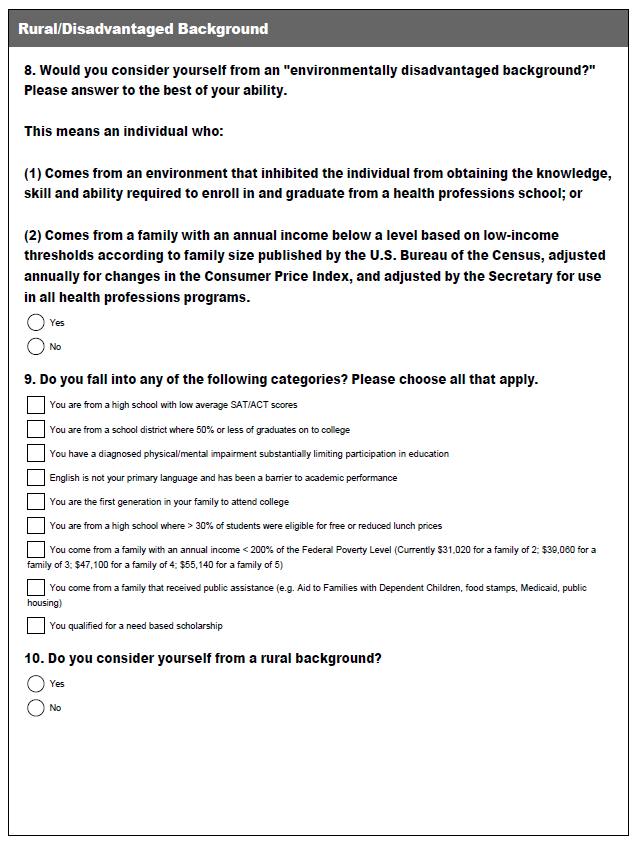
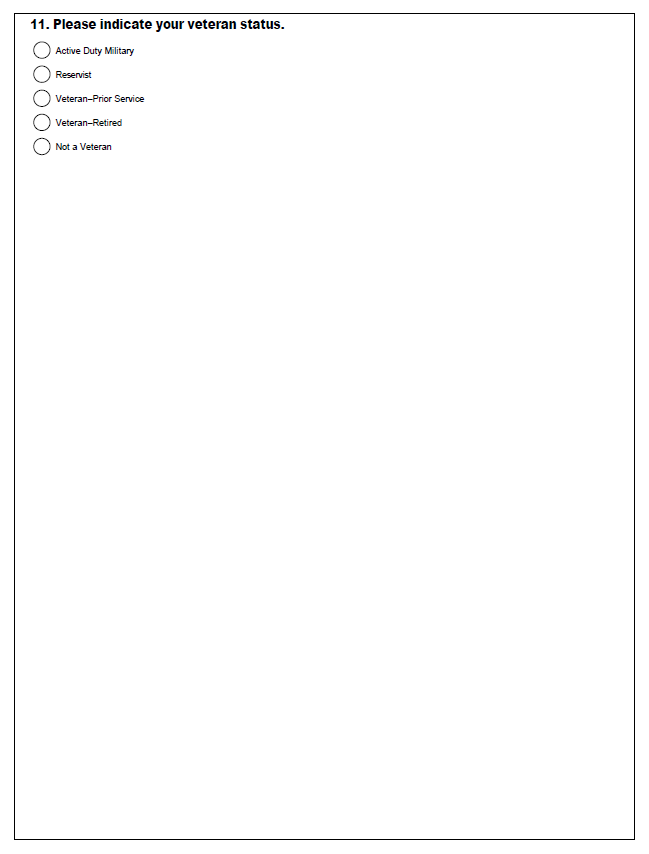

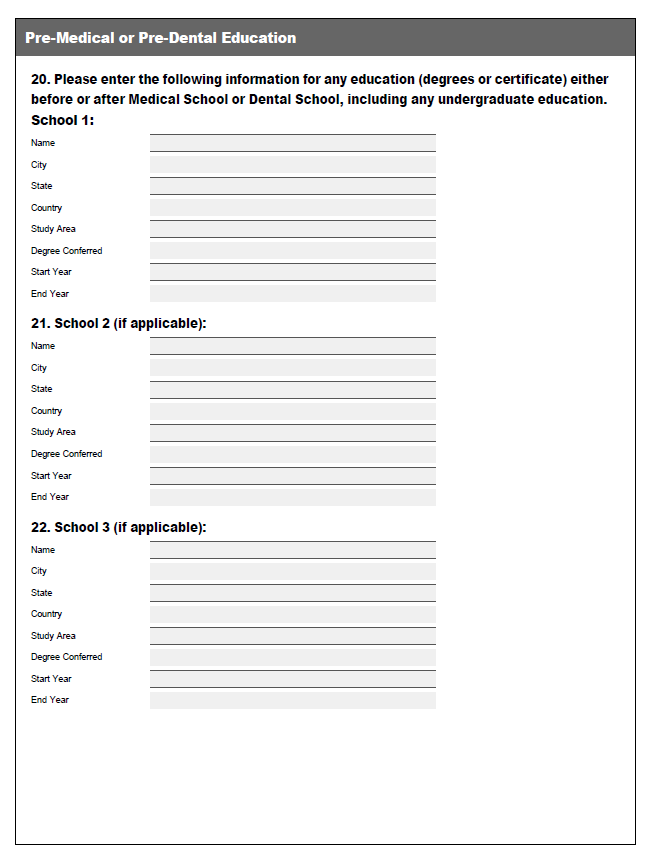
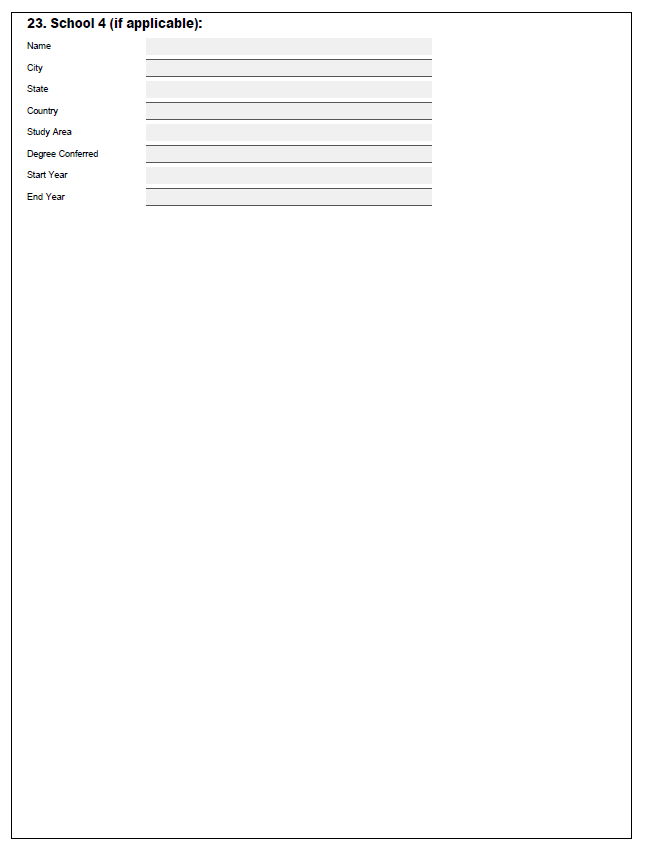
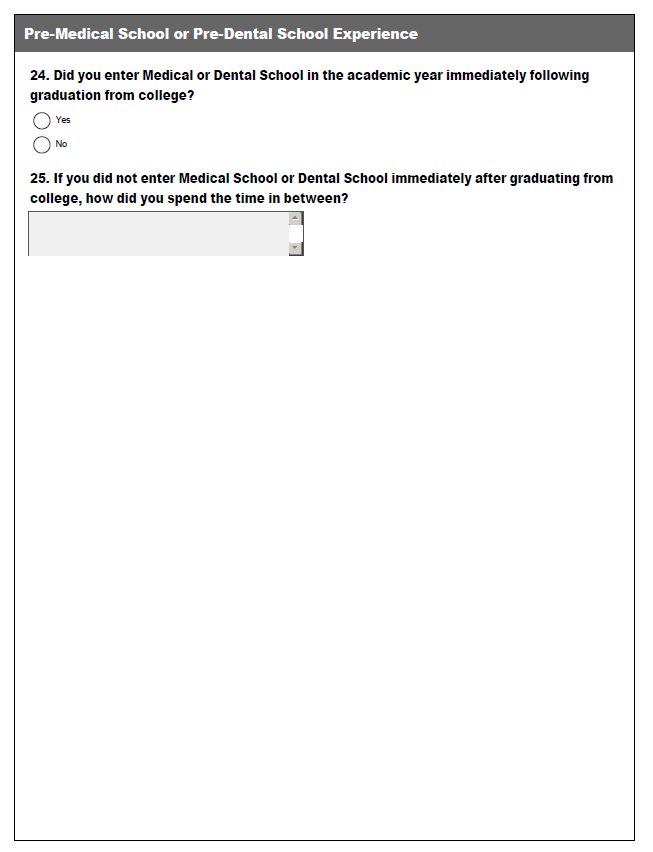

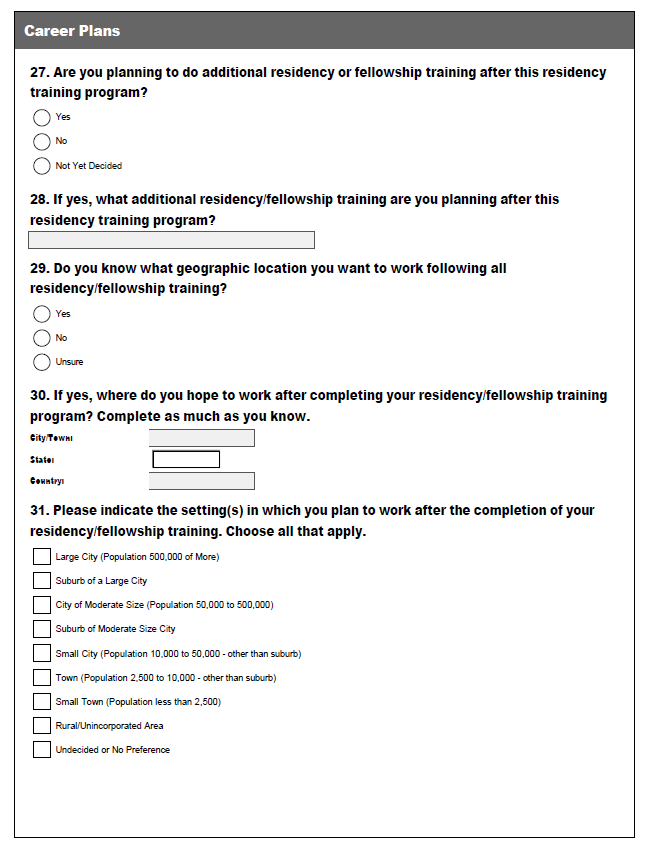
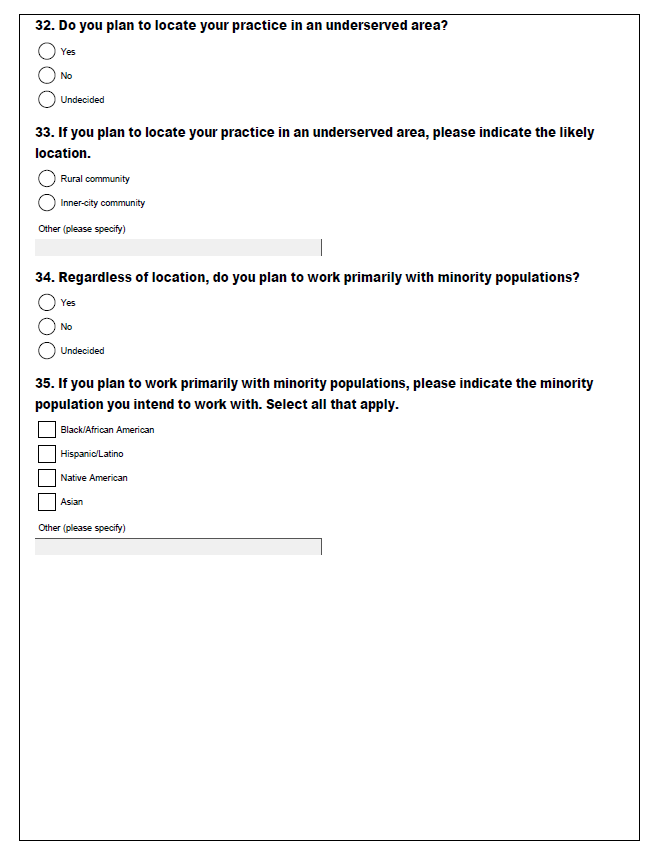
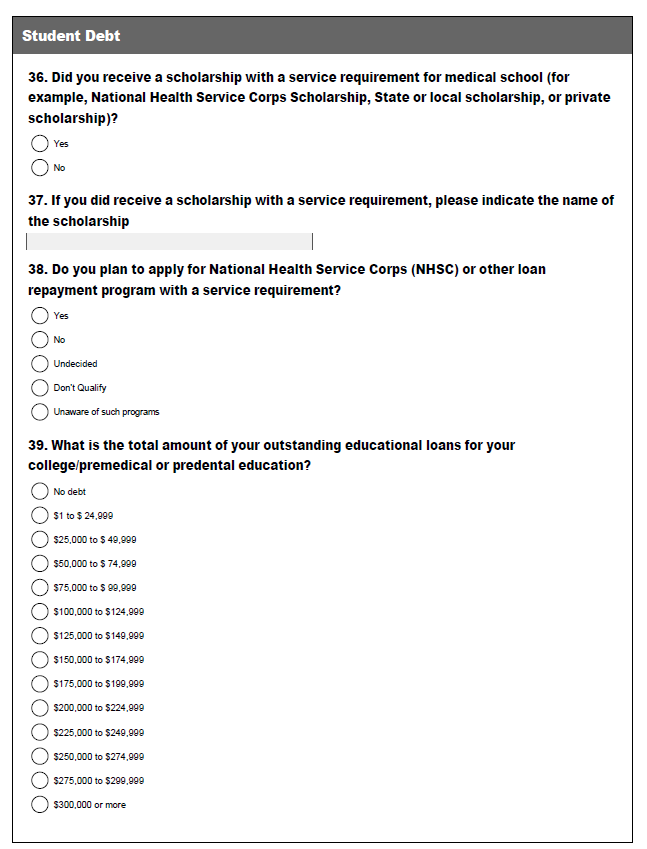

Appendix C: Graduation Survey
The
Graduation Survey will collect both identified and anonymous data,
and is separated into two parts: 1) the collection of identifiable
data (career plan information and updated contact information); and
2) the collection of anonymous feedback on the THC residency
program.
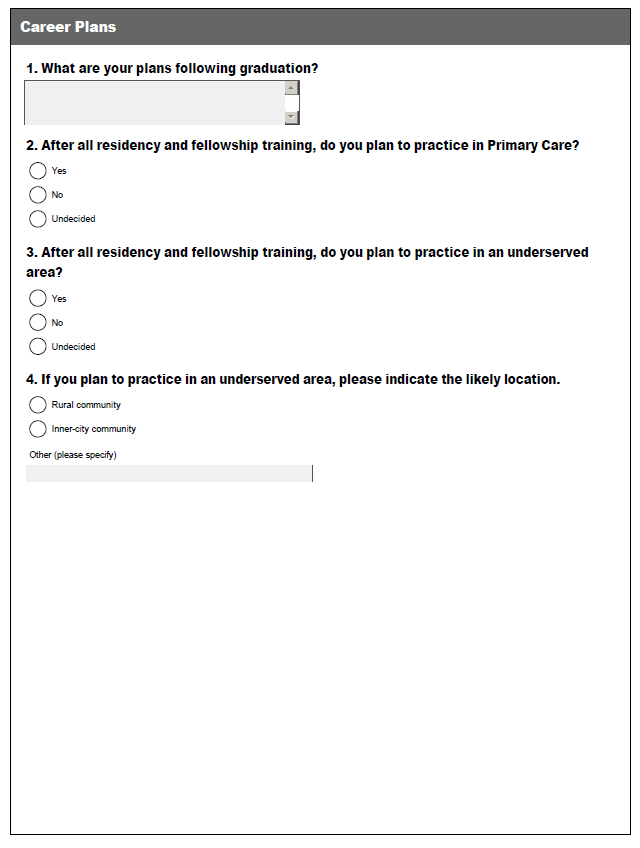
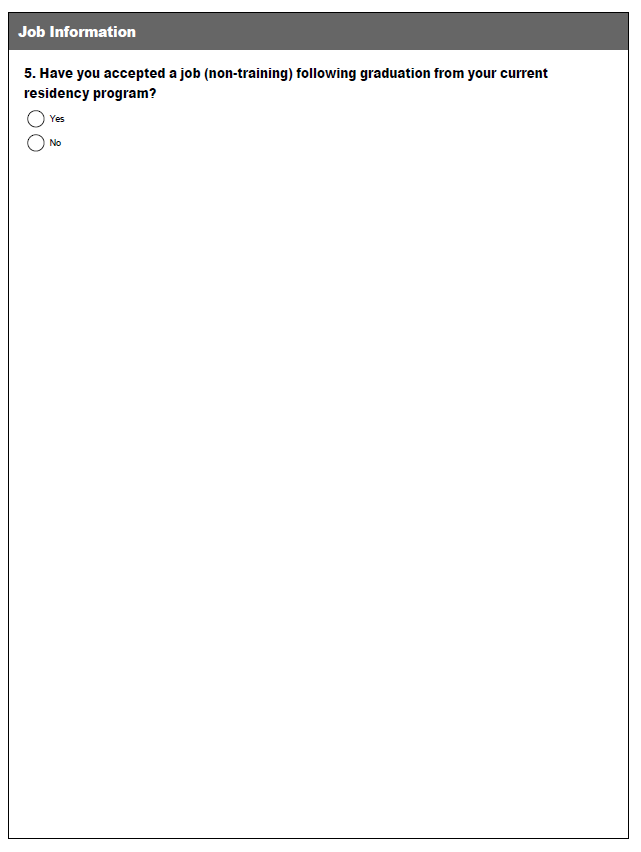
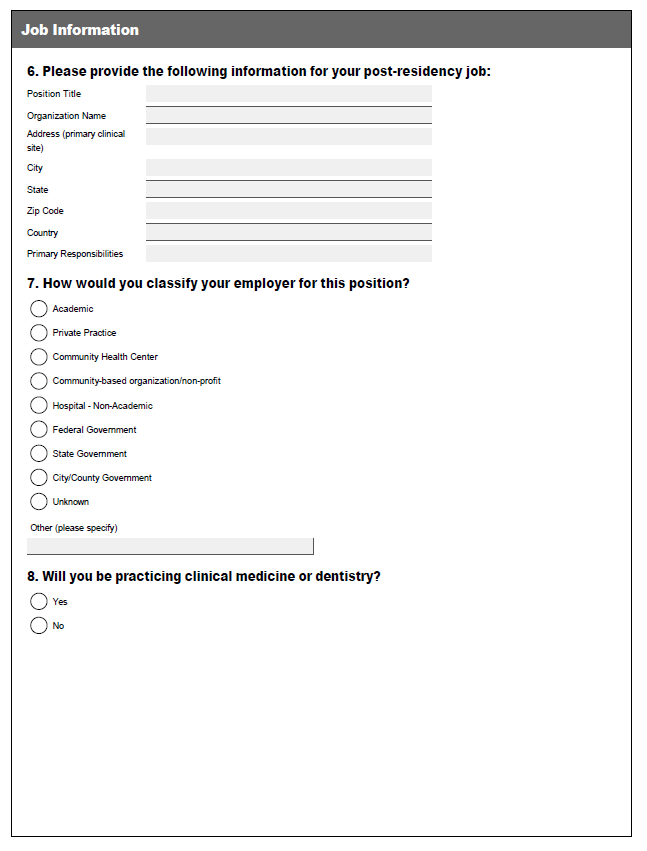



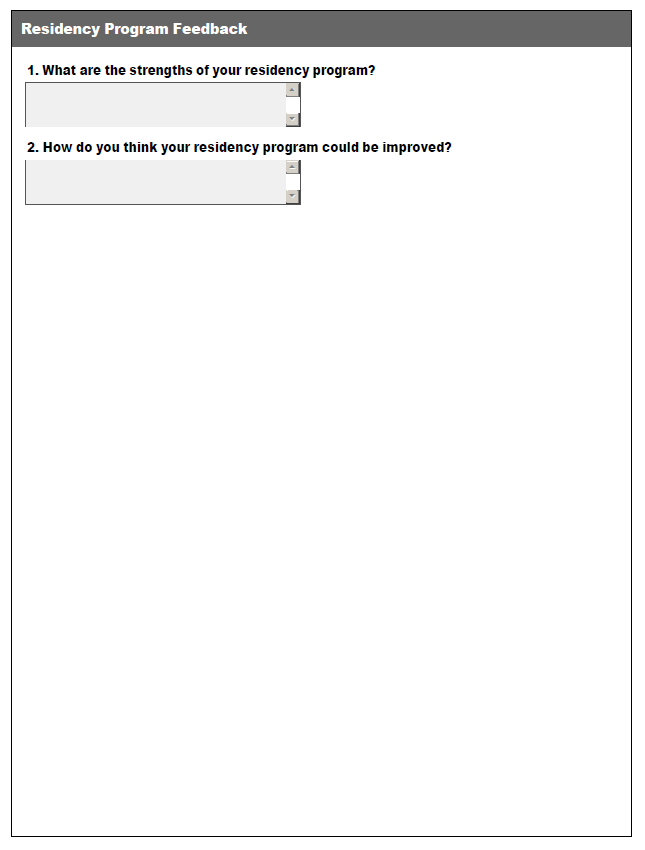

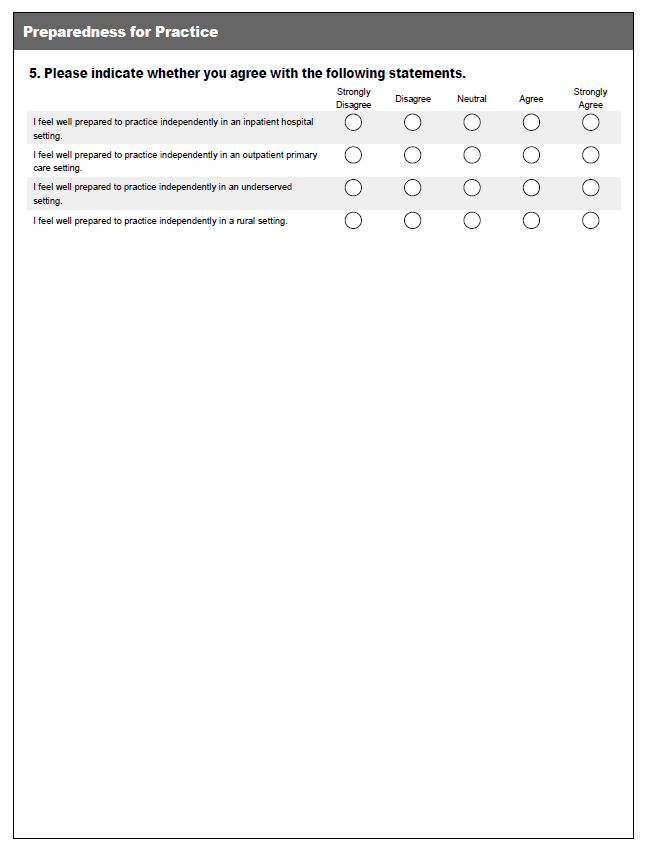
Appendix D: Graduate Survey
The Graduate Survey will collect both identified and anonymous data, and is separated into two parts: 1) the collection of identifiable data (career plan information and updated contact information); and 2) the collection of anonymous feedback on the THC residency program.







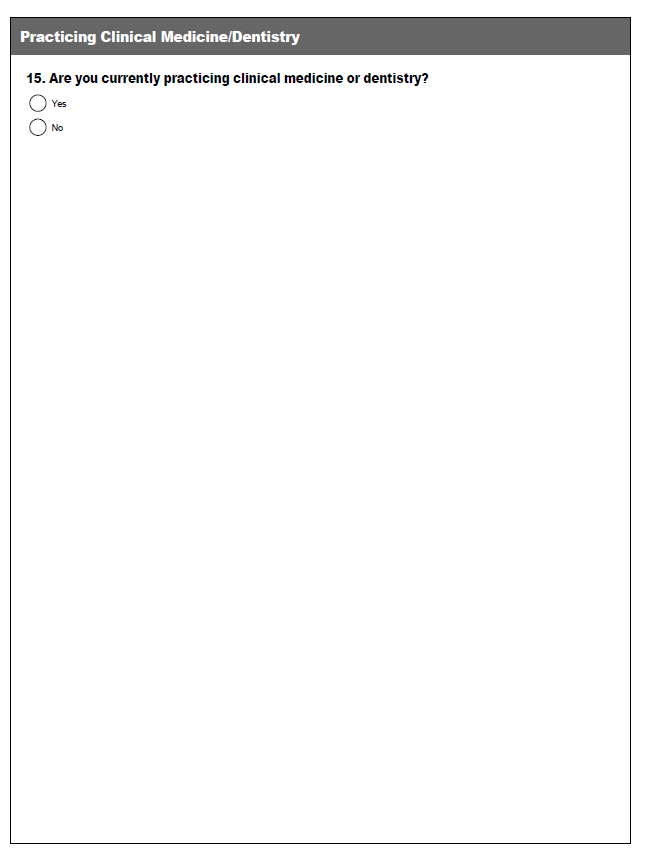
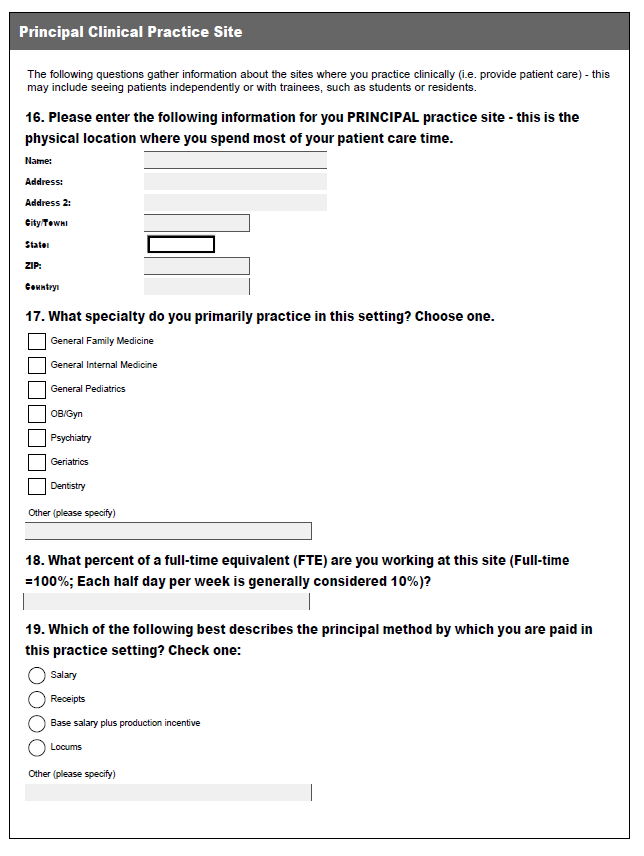
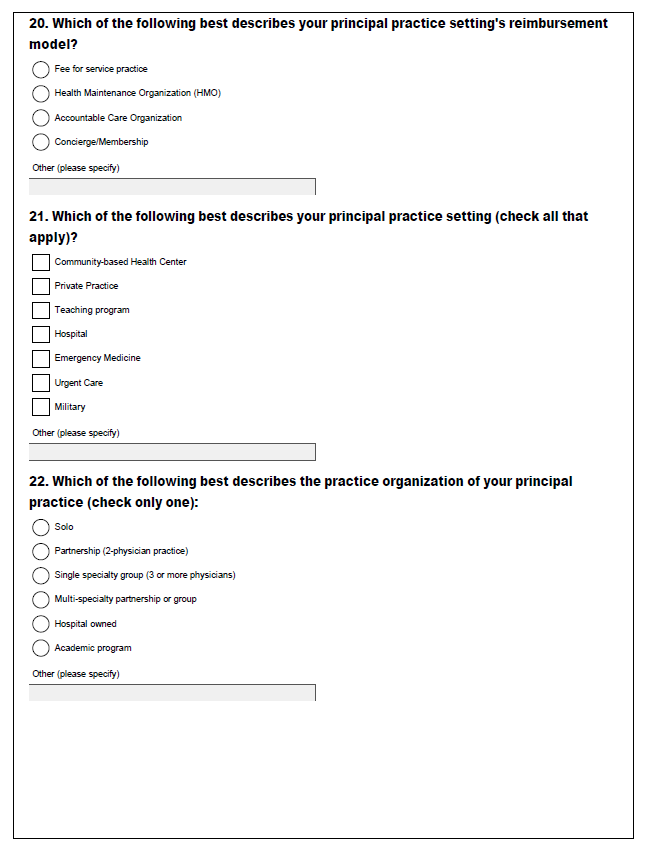


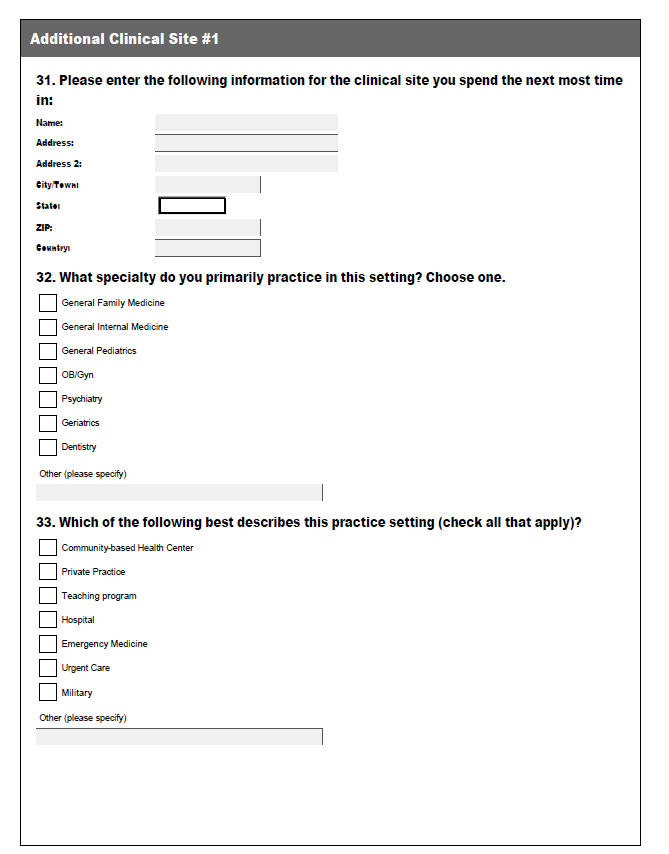

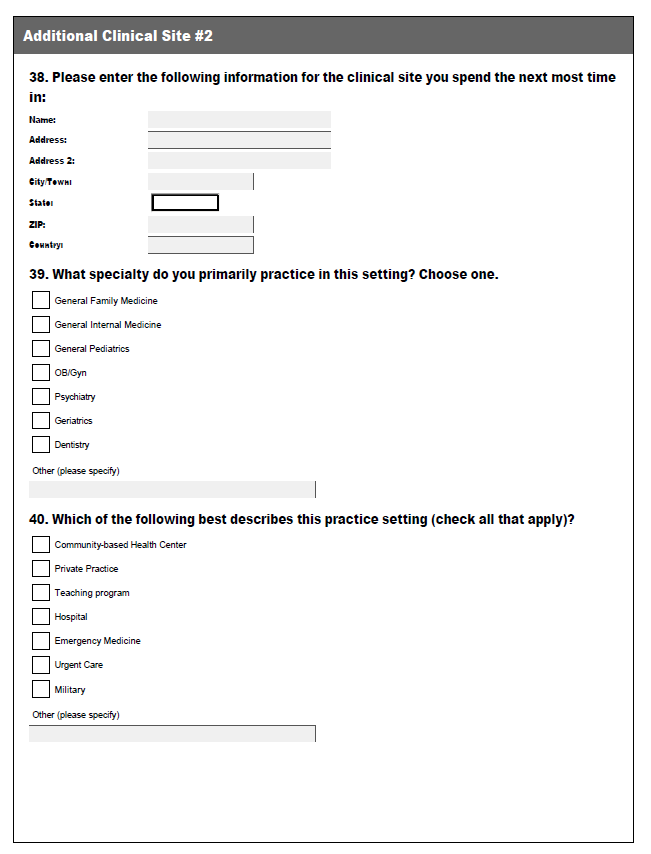
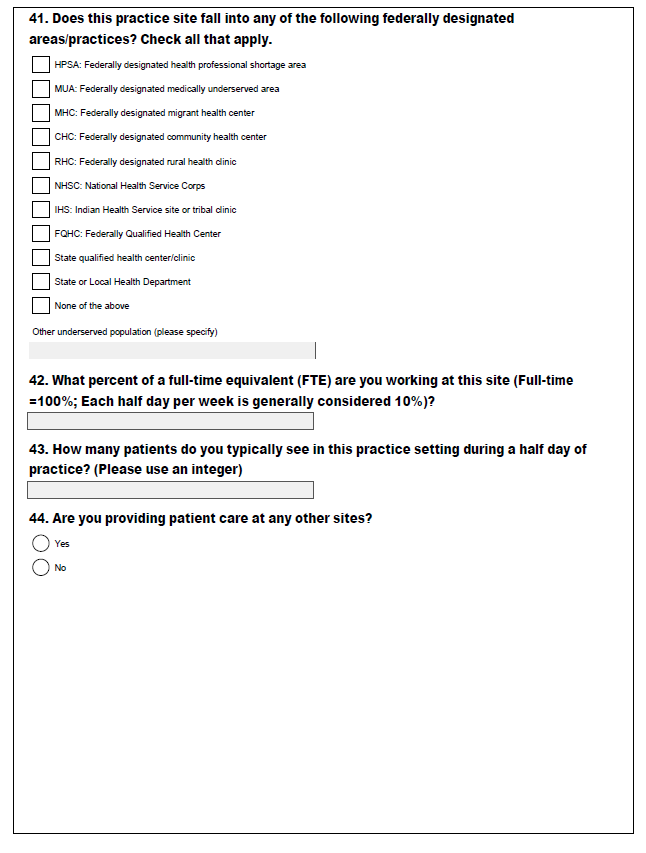

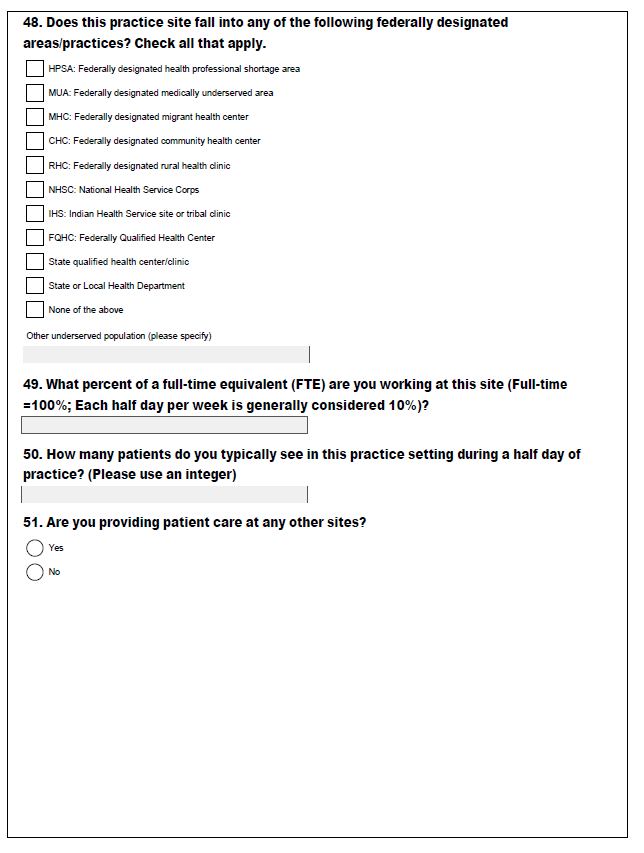
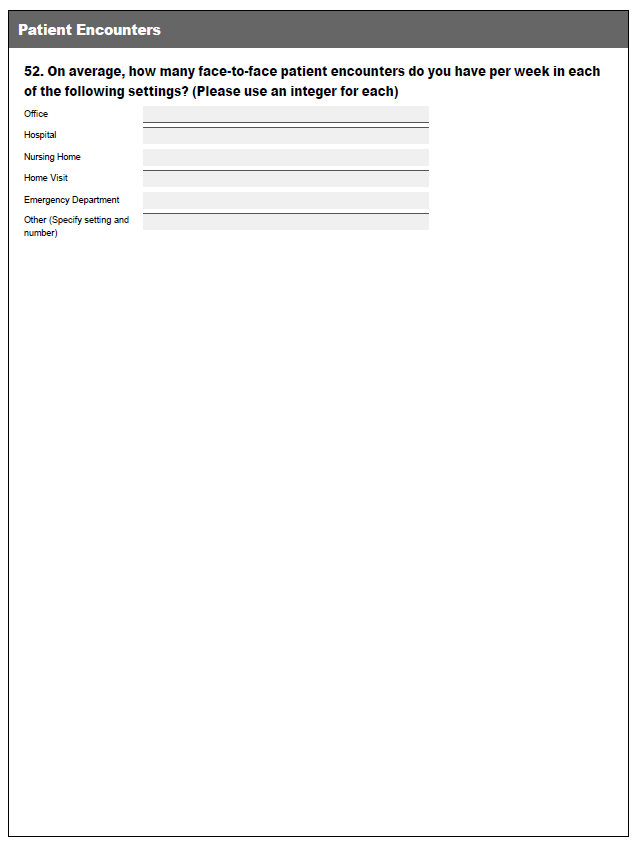
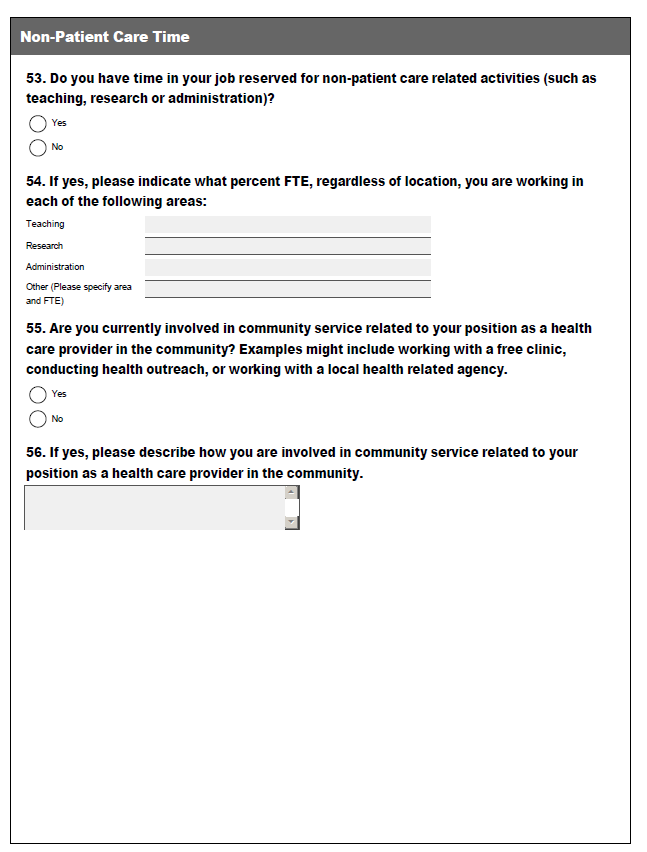
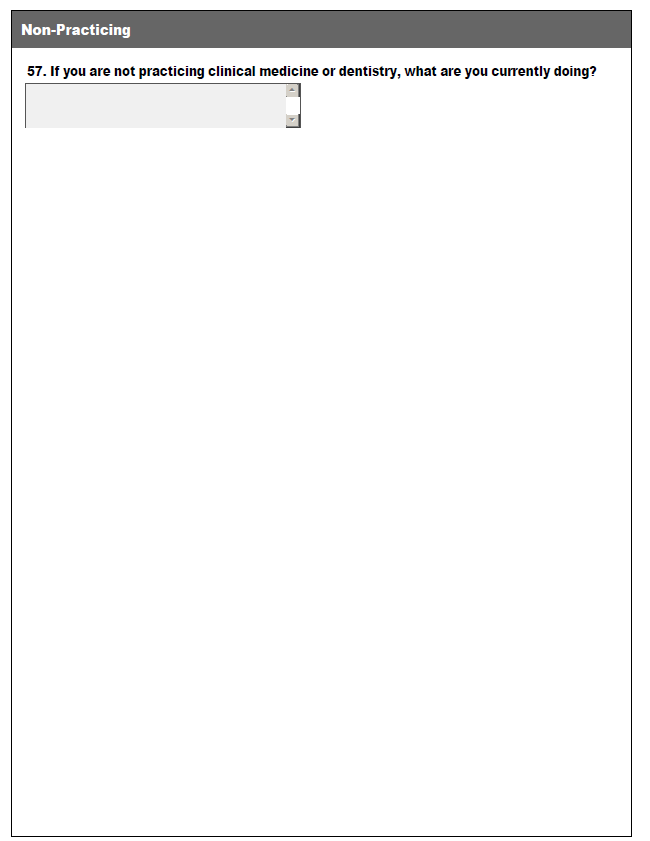

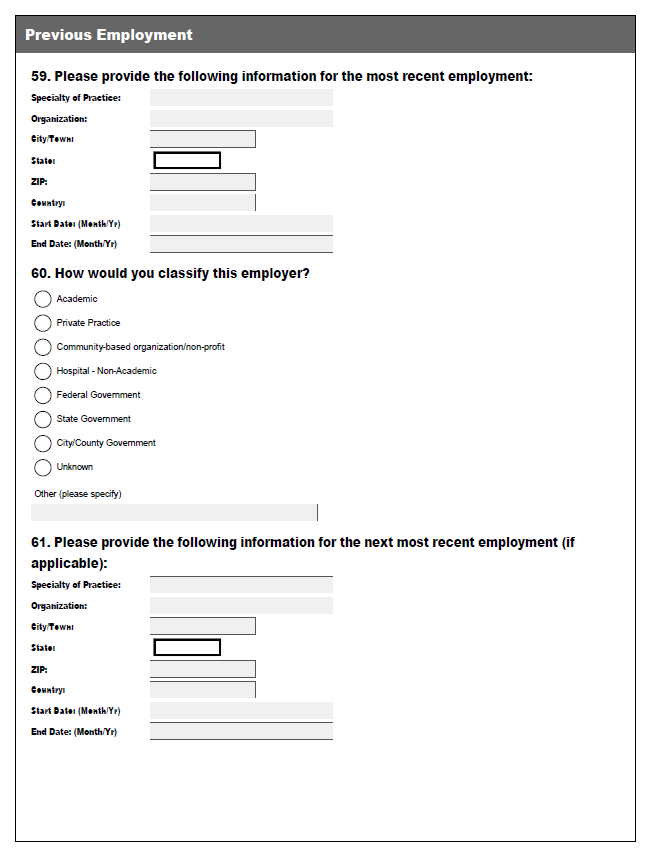
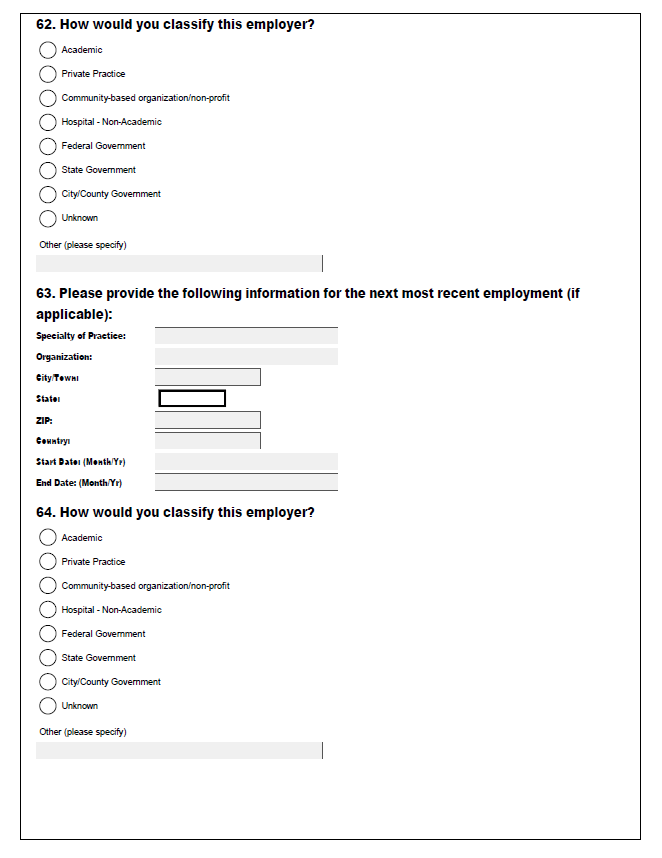


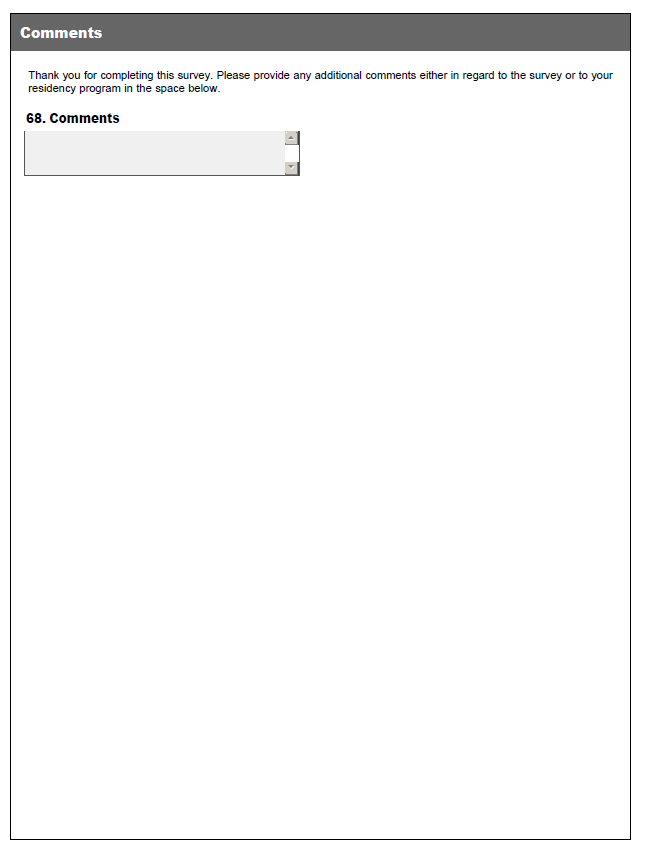
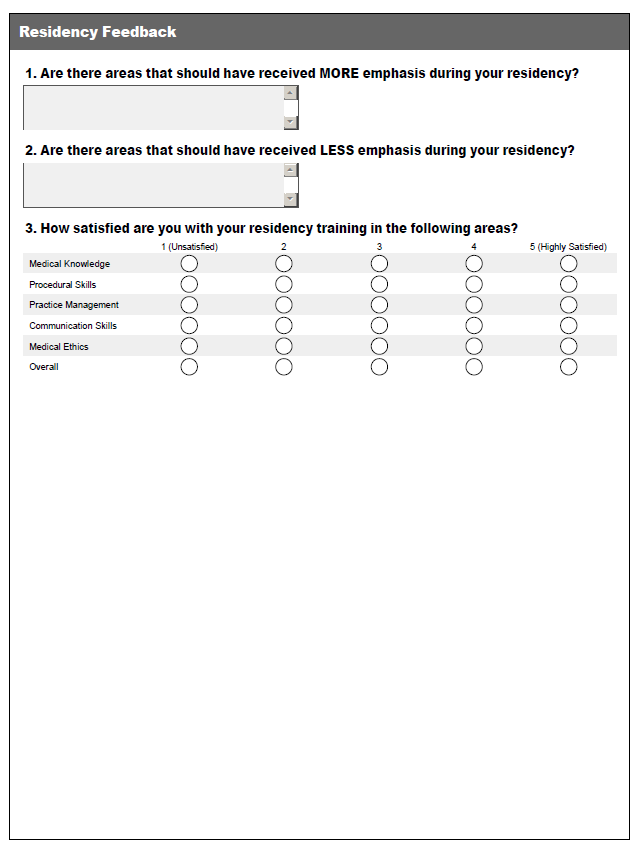
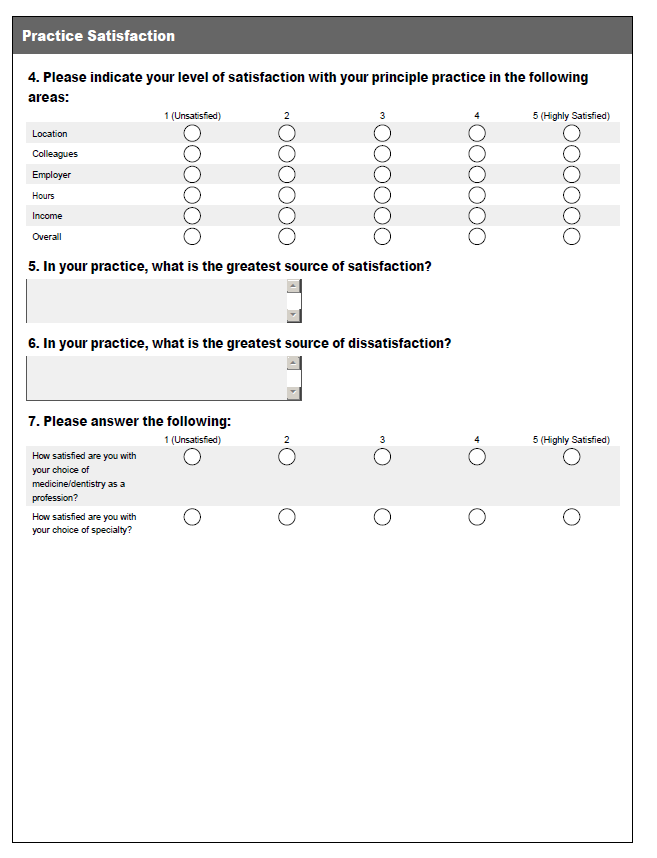
Appendix E: 60-day Federal Register Notice
 Federal
Register /
Vol. 78,
No. 113
/ Wednesday,
June 12,
2013 /
Notices
Federal
Register /
Vol. 78,
No. 113
/ Wednesday,
June 12,
2013 /
Notices
DEPARTMENT OF HEALTH AND HUMAN SERVICES
Health Resources and Services Administration
Agency Information Collection Activities; Proposed Collection; Public Comment Request
AGENCY: Health Resources and Services Administration, HHS.
ACTION: Notice.
SUMMARY: In compliance with the requirement for opportunity for public comment on proposed data collection projects (Section 3506(c)(2)(A) of the Paperwork Reduction Act of 1995), the Health Resources and Services Administration (HRSA) announces plans to submit an Information Collection Request (ICR), described below, to the Office of Management and Budget (OMB). Prior to submitting the ICR to OMB, HRSA seeks comments from the public regarding the burden estimate, below, or any other aspect of the ICR.
DATES: Comments on this Information Collection Request must be received within 60 days of this notice. ADDRESSES: Submit your comments to [email protected] or mail the HRSA Information Collection Clearance
Officer, Room 10–29, Parklawn Building, 5600 Fishers Lane, Rockville, MD 20857.
FOR FURTHER INFORMATION CONTACT: To
request more information on the proposed project or to obtain a copy of the data collection plans and draft instruments, email [email protected] or call the HRSA Information Collection Clearance Officer at (301) 443–1984.
SUPPLEMENTARY INFORMATION: When
submitting comments or requesting information, please include the information request collection title for reference.
Information Collection Request Title:
Evaluation and Initial Assessment of
HRSA Teaching Health Centers. OMB No. 0915–xxxx—New.
Abstract: Section 5508 of the
Affordable Care Act of 2010 amended section 340H of the Public Health Service Act to establish the Teaching Health Center Graduate Medical Education program to support the expansion of new and existing primary care residency training programs in community-based settings. The primary goals of this program are to increase the production of primary care doctors who are well prepared to practice in community settings, particularly with underserved populations, and to improve the overall number and geographic distribution of primary care providers.
To ensure these goals are achieved,
the George Washington University (GW) will conduct an evaluation of the training, administrative and organizational structures, clinical service, challenges, innovations, costs associated with training, and outcomes of Teaching Health Centers (THCs). GW has developed a program data collection tool that assesses basic organizational and training characteristics of the programs (including program specialty, numbers trained, training sites, educational partners, and residency program financing), educational initiatives (particularly around training for changing health care delivery systems and community experiences), and health center characteristics (including current workforce and vacancies, clinical service provided by residents, and participation in workforce programs such as the National Health Service Corps).
Questionnaires have also been
developed for implementation with all THC matriculating residents, graduating residents, and graduated residents at one year post-graduation. The matriculation questionnaire aims to collect background information on THC residents to better understand the
characteristics of individuals who apply and are accepted to THC programs. The graduation questionnaire collects information on career plans. The alumni questionnaire collects information on career outcomes (including practice in primary care and in underserved settings) following graduation as well as feedback on the quality of training.
Statute requires that THC programs report annually on the types of primary care resident approved training programs that the THCs provided for residents, the number of approved training positions for residents, the number of residents who completed their residency training at the end of the academic year and care for vulnerable populations, and any other information as deemed appropriate by the Secretary. The described data collection activities will serve to meet this statutory requirement for the THC programs in a uniform and consistent manner and will allow comparisons of this group to other trainees in non-THC programs.
Burden Statement: Burden in this context means the time expended by persons to generate, maintain, retain, disclose or provide the information requested. This includes the time needed to review instructions; to develop, acquire, install and utilize technology and systems for the purpose of collecting, validating and verifying information, processing and maintaining information, and disclosing and providing information; to train personnel and to be able to respond to
a collection of information; to search data sources; to complete and review the collection of information; and to transmit or otherwise disclose the information. The total annual burden hours estimated for this Information Collection Request are summarized in the table below.
Total Estimated Annualized burden hours:
Form name |
Number of respondents |
Number of responses per respondent |
Total responses |
Average burden per response (in hours) |
Total burden hours |
Program Data Collection Tool ............................................. |
40 |
1 |
40 |
8 |
320 |
THC Graduate Survey ......................................................... |
200 |
1 |
200 |
0.33 |
66 |
THC Matriculant Survey ....................................................... |
200 |
1 |
200 |
0.25 |
50 |
THC Graduation Survey ...................................................... |
200 |
1 |
200 |
0.25 |
50 |
Total .............................................................................. |
640 |
........................ |
640 |
........................ |
486 |
 35286 Federal
Register /
Vol. 78,
No. 113
/ Wednesday,
June 12,
2013 /
Notices
35286 Federal
Register /
Vol. 78,
No. 113
/ Wednesday,
June 12,
2013 /
Notices
Dated: June 6, 2013.
Bahar Niakan,
Director, Division of Policy and Information Coordination.
[FR Doc. 2013–13918 Filed 6–11–13; 8:45 am]
BILLING CODE 4165–15–P
1 AAMC Survey of Resident/Fellow Stipends and Benefits, 2012. Available at: https://www.aamc.org/download/312786/data/2012stipendsurveyreportfinal.pdf
| File Type | application/vnd.openxmlformats-officedocument.wordprocessingml.document |
| File Title | Instructions for writing Supporting Statement A |
| Author | Jodi.Duckhorn |
| File Modified | 0000-00-00 |
| File Created | 2021-01-28 |
© 2026 OMB.report | Privacy Policy
